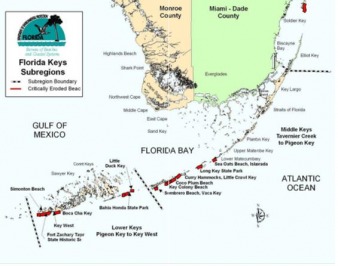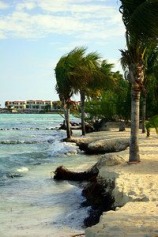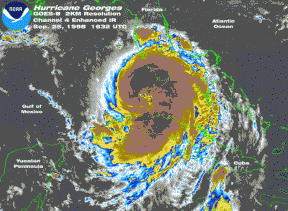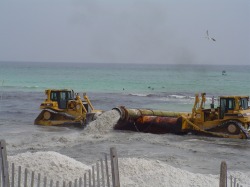Erosion

Criticaly Eroded Beaches in the Florida Keys (symbolized in red)
There is a total of 36.3 miles of beaches that line the Florida Keys and attract both tourists and marine life. Unfortunately, 10.2 miles of this, or 28% of the beaches that line the Keys are deemed critically eroded. So far, with the effort of the state of Florida, 1.4 miles of the beaches have been restored and maintained leaving 8.8mi left in critical state. The two regions that have been hit the hardest are the Middle Keys and the Lower Keys. The Middle Keys region spans from Tavernier Creek to Pigeon Key and currently has 3.5 miles of critically eroded beaches along its shoreline. The hardest hit of all the sub-regions in the Keys is the span from Pigeon Key to Key West, Florida. This region alone has 6.7 miles of critically eroded beaches (Bureau, 2008).

Eroded Shorline in Florida
The climate in the Florida Keys has to be explored in order to understand the extent of the erosion. Tropical storms, namely hurricanes in this region, are a big factor in the sediment transport. Hurricanes in the Northern Hemisphere form in the south and travel north in a counterclockwise rotation. The characteristics of a hurricane are warmer temperatures, high winds, and precipitation. In the cause of the erosion in the Keys, high winds play a main role. With the increase velocity inducing a shear stress on the water, the significant wave height increases and larger waves hit the shore. This produces more energy that can carry sediment away from the beach in larger quantities and also at a faster rate or travel.
Another cause of sediment transport in the Keys is actually caused by the increased effects on wave height from man-made structures such as seawalls and revetments. Seawalls are a vertical structure to protect the shore against erosion that rely on their pure weight to prevent moments or forces to be created and make the seawall fail. On the other hand, revetments are sloped areas that decrease the wave energy and therefore, reduce the effects of erosion. Both of these structures produce a reflection of a wave which increases the wave heights by superposing the reflected wave height onto the original wave height.

Hurricane Georges over the Florida Keys
Storm surges are atmospheric disturbances created by the combination of high winds and low air pressures. In this area, a storm surge is most commonly known as a hurricane. The list of the hurricanes that were the main factors affecting the beaches were Hurricane Andrew, Hurricane Georges, Hurricane Irene, Middle and Lower Keys, Hurricane Rita, and Hurricane Wilma. The main hurricane that started the erosion of the critically eroded beaches was Hurricane George which occurred from September 21-30, 1998 killing 600 people and causing $5.9 billion dollars in damages. The affects felt in the Keys include wind speeds up to 90mph for over more than 10 hours in duration. There were also 1,400 homes damaged, and 150 homes were destroyed. This 90mph wind induced a great amount of shear stress on the coastal water surface. Using the JONSWAP method, a significant wave height of 18.9m was calculated.
Current Solution

Dumping borrow sand on the beach
Currently the process of restoring the beaches in much of the Keys is to truck sand in from a different location and place it on the sites of the critically eroded beaches. Vegetation is also grown in order to reinforce the sand and prevent further beach erosion. However, these efforts are very costly due to the shipping costs, the labor costs, and also the material costs.
